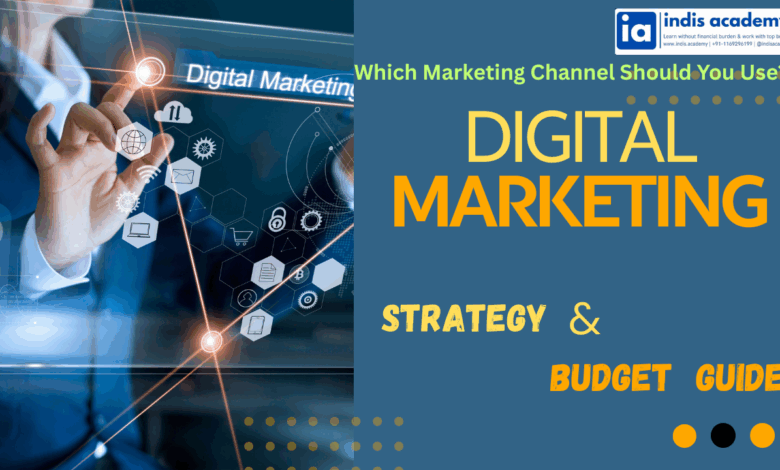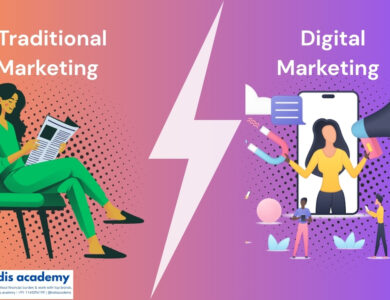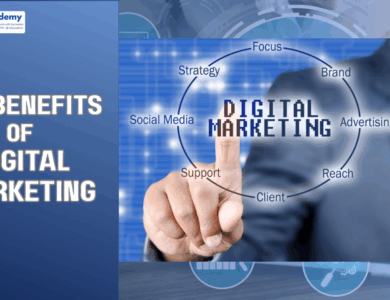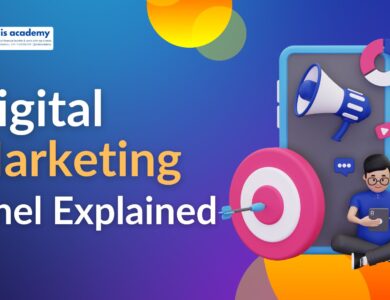Which Marketing Channel Should You Use? A Strategy & Budget Guide
Discover the best marketing channels for your business with this strategy and budget guide. Learn how to allocate resources for maximum impact.

In today’s ever-evolving digital landscape, knowing how to market isn’t enough you need to know where to market. With countless platforms and tactics available, the real challenge isn’t starting your marketing campaign, it’s choosing the right channel for your business goals and budget.
Should you double down on SEO? Invest in paid ads? Go viral on social media? Or build a community through email? The answer varies for every brand and what works for one company might drain the budget of another.
This in-depth guide will help you cut through the noise, understand how each channel functions, and choose the best digital marketing channels tailored to your business type, strategic objectives, and available resources.
Learn AI & Digital Marketing,
Pay Fees After Placement
- ✅ Minimal Admission Fees
- ✅ No Loan or Income Sharing Agreement
- ✅ 100% Placement Support
- ✅ ISO & Govt Registered Certificate
- ✅ Practical 3+1 Months Duration
Get a free counseling call. We’ll guide you through learning, certification, and job placement.
Request a Free Call Back
Takes less than a minute.
1. Understanding Your Marketing Goals
Before selecting a channel, it’s critical to define your marketing objectives. This isn’t a one-size-fits-all decision each goal requires a different tactical approach:
Common Marketing Goals
- Brand Awareness: Introducing your business to new audiences.
- Lead Generation: Collecting contact information for potential customers.
- Sales/Conversions: Encouraging a direct action a purchase, booking, or registration.
- Customer Engagement: Driving interaction and relationship-building with your brand.
- Customer Retention: Keeping your existing customers coming back.
Different channels are better suited for different goals:
- Social media is excellent for awareness and engagement.
- Email marketing shines for nurturing and retention.
- SEO and PPC are ideal for lead generation and conversions.
Start by narrowing down what success looks like for your brand, then align that goal with the appropriate channel.
Also Read: Growth Hacking vs Digital Marketing: Which One Drives Faster Results?
2. The Major Marketing Channels (When to Use, What to Expect)
1. Search Engine Optimization (SEO)
SEO focuses on optimizing your website and content to appear in unpaid search engine results.
- Best for: Long-term visibility, credibility, organic traffic
- Key Tactics: On-page SEO, backlink building, content clusters
- Timeframe: 3–6 months to see meaningful results
- Budget Range: Moderate (content writers, tools, SEO audits)
Use SEO when:
- You have time to build authority.
- You want consistent traffic that doesn’t rely on ad spend.
- You aim to be found by users actively searching for your product or service.
2. Pay-Per-Click Advertising (PPC)
PPC includes platforms like Google Ads, Bing Ads, and paid placements on websites or apps.
- Best for: Quick traffic, high-intent lead generation, ecommerce sales
- Key Tactics: Keyword bidding, landing page optimization, retargeting
- Timeframe: Immediate (as soon as the campaign goes live)
- Budget Range: Flexible but often costly, especially in competitive niches
Use PPC when:
- You need immediate visibility.
- You have high-converting offers.
- You want to test messaging and audience segments quickly.
3. Social Media Marketing
This involves creating and sharing content on platforms like Facebook, Instagram, Twitter (X), LinkedIn, Pinterest, and TikTok.
- Best for: Brand awareness, relationship-building, content distribution
- Key Tactics: Organic posting, reels, stories, influencer partnerships
- Timeframe: Short-term engagement; long-term community building
- Budget Range: Organic = free (time-cost); Paid = variable
Use social media when:
- Your target audience is active on these platforms.
- You have strong visual/creative assets.
- You want to humanize your brand.
4. Email Marketing
Email is a direct and permission-based channel. It works well across the funnel.
- Best for: Lead nurturing, retention, sales recovery
- Key Tactics: Automation, segmentation, personalization
- Timeframe: Mid to long-term (builds with list growth)
- Budget Range: Low to moderate (email platform, copywriters)
Use email when:
- You have a growing list of leads or customers.
- You want to build loyalty or upsell existing buyers.
5. Content Marketing
Content marketing builds authority and trust by providing valuable content.
- Best for: SEO, lead nurturing, inbound traffic
- Key Tactics: Blogs, whitepapers, videos, webinars, case studies
- Timeframe: Medium to long-term (requires consistency)
- Budget Range: Medium to high (writers, designers, distribution)
Use content marketing when:
- Your audience needs education before buying.
- You want to rank for long-tail keywords.
- You aim to create evergreen traffic sources.
6. Influencer Marketing
Working with creators who have niche audiences to promote your brand.
- Best for: B2C exposure, lifestyle branding
- Key Tactics: Product placements, sponsored content, affiliate links
- Timeframe: Short bursts (1–4 weeks)
- Budget Range: Depends on influencer tier
Use influencer marketing when:
- You want credibility with a specific audience.
- Your product is visual or experience-based.
7. Affiliate Marketing
You reward partners (affiliates) for driving traffic or sales.
- Best for: Ecommerce, software, subscription services
- Key Tactics: Commission-based payouts, tracking links, affiliate dashboards
- Timeframe: Ongoing
- Budget Range: Pay-per-sale, minimal upfront
Use affiliate marketing when:
- You want risk-free, performance-based growth.
- You can offer attractive commissions and track performance.
Also Read: Want a Career in Digital Marketing? Here’s Everything You Need to Know
3. Budgeting: How to Allocate Wisely
Your marketing budget depends on:
- Business size & revenue
- Customer Lifetime Value (CLV)
- Cost Per Acquisition (CPA) goals
Recommended Budget Allocation:
- Startups (Limited budget): Focus on organic content, SEO, email, and social.
- SMBs (Growing budget): Blend of SEO, paid ads, and content.
- Enterprises: Omni-channel with advanced tools, programmatic ads, and team specialization.
A common guideline: 7–10% of total revenue should be allocated to marketing. Within that:
- 30–40% can go to paid ads
- 20–30% to content and SEO
- 10–15% to email and automation
- 5–10% to branding/social media growth
Test, measure, and re-allocate monthly.
4. Decision Matrix: What Channel is Right for You?
| Goal | Best Channels |
|---|---|
| Brand Awareness | Social Media, Display Ads, Influencer Collabs |
| Lead Generation | Google Ads, Facebook Lead Forms, SEO |
| Product Sales | Google Shopping Ads, Instagram, Email Campaigns |
| Engagement | Interactive Posts, Reels, Webinars, Polls |
| Retention | Email, Loyalty Programs, Retargeting Ads |
| Education/Trust | Blogging, YouTube, Webinars, LinkedIn |
5. Multi-Channel vs Omni-Channel Marketing
Multi-channel means using multiple platforms but managing them separately. Omni-channel connects them for a seamless customer experience.
- Example of Multi-channel: Running separate email, social, and ad campaigns.
- Example of Omni-channel: A user sees a Facebook ad, signs up via email, and receives a personalized WhatsApp message + retargeted Google ad.
For beginners, multi-channel is more achievable. As you grow, invest in CRM and automation tools (like HubSpot, ActiveCampaign) for an omni-channel approach.
Also Read: Top 10 Work From Home Digital Marketing Jobs to Apply for in May 2025
6. Common Mistakes to Avoid When Choosing Channels
- Spreading too thin: Trying to be on every platform with no focus.
- Ignoring your audience: Marketing where your users aren’t active.
- Overspending early: Blowing the budget on PPC without testing first.
- No tracking setup: Running campaigns without tracking ROI or KPIs.
- Neglecting content: Channels work best when fueled by great content.
Conclusion: Start Small, Grow Smart
There’s no universally “right” channel only the one that aligns with your goals, audience, and budget. The key is to start with clarity, test strategically, double down on what works, and expand from there.
Choose 1–2 core channels based on your strengths and audience behavior. Focus, measure, improve.
Remember: Even with a modest budget, a well-aligned strategy can beat a scattered one backed by big money.
In digital marketing, precision beats presence. Choose wisely, execute smartly, and scale sustainably.





